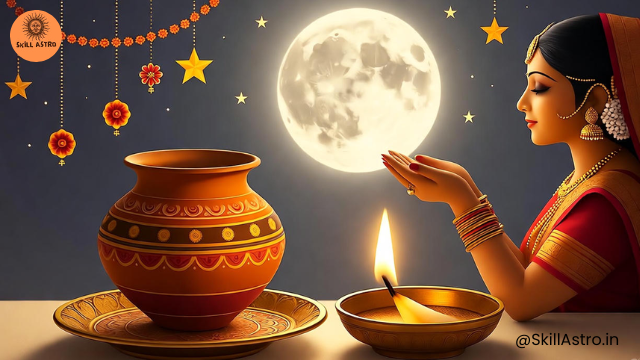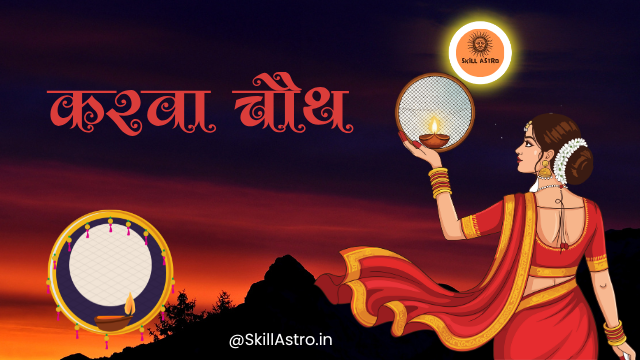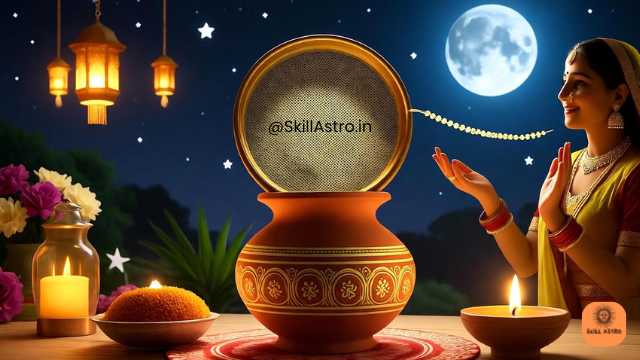
Karva Chauth is a cherished festival in Indian culture that symbolizes not just the unbreakable bond between husband and wife, but also embodies trust, sacrifice, and unwavering devotion. Celebrated annually on the Chaturthi (fourth day) of the Krishna Paksha in the Kartik month, married women observe a day-long fast for their husbands' long life and prosperity. The fast is broken at night after sighting the moon and offering it arghya (water offerings). But have you ever wondered how this beautiful tradition began? Let's delve deep into the story of Karva Chauth and explore its mythological and historical tales.
The Significance of Karva Chauth
The importance of Karva Chauth goes beyond religious or traditional rituals—it's an occasion that strengthens the marital bond. On this day, women pray for their husbands' longevity and well-being. The fast leaves a profound impact not only physically but also mentally and spiritually. It's a nirjala vrat (without water or food), highlighting women's unwavering faith and the depth of their love.
The name "Karva Chauth" comes from "karva" (a small earthen pot used in worship) and "chauth" (referring to the fourth day). The moon holds special significance, symbolizing love and peace.
Mythological Stories Behind Karva Chauth

Several mythological stories surround Karva Chauth, adding depth to its celebration. Passed down through generations, these tales touch hearts even today. Here are some prominent ones:
- The Story of Veeravati
The most famous tale is that of Veeravati, a beautiful and devoted wife. She was the only sister among seven brothers and deeply loved her husband. On her first Karva Chauth, she fasted rigorously for his long life and grew extremely weak due to the nirjala observance.
Unable to bear her suffering, her brothers tricked her. They lit a lamp behind a tree and used a sieve to create the illusion of the moon rising. Believing it, Veeravati offered arghya to the false moon and broke her fast. Tragically, news of her husband's death arrived soon after. Devastated, she prayed to Goddess Parvati. Moved by her devotion and love, Parvati revived her husband and blessed her with eternal marital bliss. This story elevated the importance of Karva Chauth. - The Story of Satyavati and Savitri Another tale involves Savitri, who snatched her husband Satyavan's life back from Yama (the god of death). Savitri performed intense penance and observed Karva Chauth for his longevity. Her unwavering resolve forced Yama to restore Satyavan's life. This narrative showcases the power of faith and love in the Karva Chauth fast.
- The Story of Karva The festival's name derives from Karva, a devoted wife. One day, her husband was bathing in a river when a crocodile seized him. Karva prayed to Yama and, through the power of her fast, bound the crocodile. She demanded her husband's safety from Yama, who, impressed by her devotion, freed him. This tale popularized the name Karva Chauth.
Karva Chauth Puja and Traditions
The rituals and customs of Karva Chauth make the festival truly special. Women wake early, bathe, and take a vow for the fast. They abstain from food and water all day. Essentials include a karva (earthen pot), sieve, lamp, and puja thali.
Puja Procedure:
- Morning Preparation: After bathing, women adorn themselves in solah shringar (16 adornments). In some regions, there's a tradition of sargai, where the mother-in-law gives her daughter-in-law a meal thali.
- Evening Puja: In the evening, worship Goddess Parvati, Lord Ganesha, and Shiva. Listen to the Karva Chauth katha, and fill the karva with water, rice, and roli.
- Offering to the Moon: At night, after the moon rises, women view it through a sieve, then look at their husbands. The husband then feeds his wife water and food to break the fast.
Social Significance of Karva Chauth
Karva Chauth isn't just religious—it's a promoter of social unity. Women gather, share stories, and exchange experiences. It strengthens family ties and fosters love and trust in society.
Karva Chauth in the Modern Era

In today's world, Karva Chauth is evolving. Traditionally for married women, now unmarried girls fast for their fiancés. Some men even join their wives in fasting, symbolizing equality and love.
Social media has added a new dimension. People share moments on Instagram, Facebook, and other platforms—mehendi designs, solah shringar, and thali photos go viral.
Tips for Celebrating Karva Chauth
- Health First: The nirjala fast can be tough. Get good sleep beforehand and eat nutritious food in sargai.
- Solah Shringar: Mehendi, bindi, bangles, and red attire enhance the day's beauty.
- Time Management: Prepare for puja and moon-sighting in advance to stay stress-free.
- Couple Time: Spend quality time together to strengthen your bond.
Interesting Facts About Karva Chauth
- Primarily celebrated in North India, like Punjab, Haryana, Uttar Pradesh, Rajasthan, and Madhya Pradesh.
- Date changes yearly based on the lunar calendar.
- In some areas, men fast for their wives, symbolizing love and equality.
- The karva represents fertility and prosperity.
Conclusion
Karva Chauth is a festival that not only fortifies marital love but also keeps alive the spirit of trust, sacrifice, and devotion. Its mythological stories teach us that true love and faith can overcome any obstacle. Whether celebrated religiously or as a symbol of love, this day brings warmth and trust to relationships.
This Karva Chauth, celebrate with your partner, support each other, and make your journey of love even stronger.
Frequently Asked Questions (FAQ)
- When and why is Karva Chauth observed? It's celebrated on the Chaturthi of Krishna Paksha in Kartik month. Married women fast for their husbands' long life and prosperity, symbolizing love, trust, and devotion.
- How is the Karva Chauth fast observed? It's a nirjala fast without food or water. Evening puja honors Goddess Parvati and Lord Ganesha; the fast breaks after moon-sighting and arghya.
- Can unmarried girls observe Karva Chauth? Yes, many now fast for their fiancés or future husbands, representing love and faith.
- What is the significance of the moon in Karva Chauth? The moon symbolizes love and peace. It's viewed through a sieve for arghya, a key ritual.
- Can men observe Karva Chauth? Yes, some men fast for their wives, embodying love and equality, strengthening the relationship.
- What is sargai? A meal thali given by the mother-in-law to her daughter-in-law before the fast starts, including nutritious food and sweets.
- What items are needed for Karva Chauth puja? Karva (earthen pot), sieve, lamp, roli, rice, water, puja thali, and images of Goddess Parvati and Lord Ganesha.
- Is there a specific time to break the Karva Chauth fast? After moonrise—view the moon through a sieve, offer arghya, then the husband feeds his wife.
- Why is listening to the Karva Chauth story important? It explains the festival's significance and myths, bringing peace and reinforcing faith.
- Is Karva Chauth only for Hindus? Yes, mainly in Hinduism, but its message of love and devotion inspires people of all faiths.